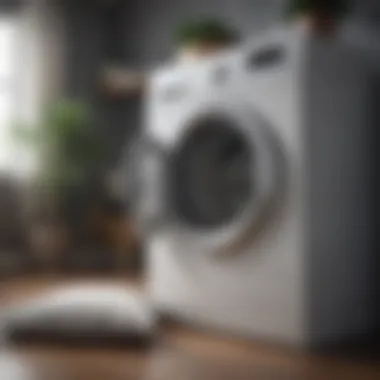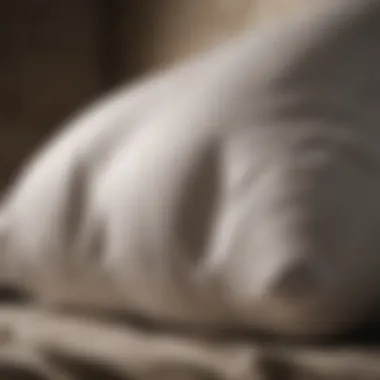Washing Pillows: A Comprehensive Guide


Intro
Pillows serve a fundamental role in our sleep experience, yet their maintenance is often overlooked. Many people use pillows without considering how they may harbor allergens, odors, and bacteria over time. This can lead to a subpar sleeping environment, which in turn can affect overall health and wellness.
Understanding how to wash pillows properly is essential for ensuring both comfort and longevity. Many misconceptions surround the proper care of pillows, particularly regarding which types can be washed in machines, washing methods, and drying techniques. Addressing these misconceptions can empower homeowners and individuals invested in their home maintenance to make informed decisions about pillow care. The discussion ahead will clarify these points and offer practical advice on maintaining your pillows, enhancing both hygiene and sleep quality.
Understanding Pillow Materials
Understanding the materials used in pillows is fundamental for anyone looking to maintain cleanliness and comfort. Different pillow fillings have varied properties that influence their maintenance, support, and overall hygiene. Knowledge about pillow materials also helps in making informed choices regarding washing and care procedures.
Types of Pillow Fillings
Down and Feather
Down and feather pillows are among the most luxurious choices available. They consist of the soft plumage from ducks or geese, providing plush comfort. Their key characteristic is their ability to conform to the head and neck's contours, improving sleep quality. However, while down offers excellent insulation, it can be challenging to clean. Prolonged exposure to moisture may cause mold or mildew, demanding particular care during washing.
Synthetic Fibers
Synthetic fiber pillows are increasingly popular due to their affordability and hypoallergenic qualities. The key characteristic of these pillows is their resistance to allergens, making them an excellent option for sensitive individuals. They are often machine washable, which simplifies maintenance. However, they may flatten over time and provide less support compared to natural materials.
Memory Foam
Memory foam pillows are designed to offer tailored support. This material molds to the shape of the sleeper's head and neck, promoting proper alignment. The unique feature of memory foam is its ability to retain its shape when not in use. This characteristic provides supportive comfort, but they can trap heat and might be difficult to wash effectively due to their density and composition.
Latex
Latex pillows are known for their durability and support. They are made from natural or synthetic latex, offering a responsive feel. The key advantage of latex is its breathability and resistance to dust mites. However, cleaning latex can pose challenges, as some varieties are not machine washable. Thus, they require gentler cleaning methods for maintenance.
Benefits and Drawbacks of Each Type
Sustainability
Sustainability is an important aspect of pillow materials. Natural options like down and latex tend to have less environmental impact compared to synthetic alternatives. They are biodegradable and usually made from renewable resources. But it can be tricky to source sustainably produced down, which raises ethical concerns. Choose brands that prioritize responsible sourcing to address these issues effectively.
Support and Comfort
Support and comfort are essential considerations when choosing pillows. Down provides unparalleled softness, while memory foam offers superior support by adapting to body shapes. On the other hand, synthetic fiber products may provide moderate comfort but often lack the structural integrity of natural materials. Evaluating these characteristics helps in selecting the right pillow for an individual's sleeping style.
Maintenance Requirements
The maintenance requirements vary significantly among pillow types. Down and feather pillows often need professional cleaning or careful washing to prevent damage. In contrast, synthetic fibers usually allow for easy machine washing. Memory foam requires that you be cautious, as many cannot tolerate water. Comfort and support depend heavily on how well the pillows are maintained.
Can You Put a Pillow in the Washer?
Washing pillows is important for maintaining hygiene and extending their lifespan. Many people wonder whether they can safely place their pillows in the washer. Understanding this topic is crucial. Not all pillows are designed to withstand machine washing, and improper cleaning can lead to damage. Here, we will explore both methodss of washing pillows and factors that determine the best choice.
Machine Washing vs. Hand Washing
Strengths and Weaknesses of Each Method
Machine washing offers a convenient solution for busy homemakers. It saves time, as the washer can clean multiple pillows at once. However, not all fabrics respond well to this method. Some fillings may clump together, affecting the pillow’s shape and comfort. Hand washing allows for a gentler approach. It gives greater control during the cleaning process, effectively removing stains without damaging the fabric. Yet, it is also more time-consuming and labor-intensive. Considering both strengths and weaknesses helps in selecting the correct cleaning method for your pillows.
Criterions for Choosing a Method
When deciding how to wash pillows, consider materials and care instructions. Heavier pillows may not clean thoroughly in a machine if overloaded. Conversely, delicate fillings like down feather can easily harm when washed by machine. Light pillows could benefit from machine washing as well. Following the care labels is vital, as they often indicate the preferred method. Evaluating these criterions is important for ensuring the longevity of the pillows.
Types of Pillows That Are Washable
Some pillows are specifically designed for machine washing, while others are not. Understanding which types can be safely washed is critical for effective cleaning.
Pillows with Removable Covers


Pillows with removable covers are a practical choice. You can easily wipe or machine wash the cover, making the cleaning process much simpler. This design maximizes comfort while extending the life of the pillow itself. However, some inner fillings might not be washable. Always check care labels to confirm appropriate cleaning methods. Removable covers provide flexibility but may lead to confusion regarding taking proper care of the inner materials.
Washable Synthetic Pillows
Washable synthetic pillows often provide significant advantages. They are generally designed to be fully machine washable, making care easy. These pillows are resistant to allergens and dust mites, appealing to many users, especially those with allergies. However, some synthetic materials may not hold their shape well after repeated washings. It is wise to follow washing instructions closely to minimize any adverse effects on the pillow's form and function.
Preparing Pillows for Washing
Preparing pillows for washing is a critical step in ensuring their cleanliness and longevity. It is essential to understand that the various materials used in pillows respond differently to washing methods. Ignoring preparation can lead to damage or insufficient cleaning, hence detracting from the overall goal of maintaining comfort and hygiene.
When preparing pillows, checking care labels and conducting pre-washing maintenance are significant. Care labels provide insights into the recommended washing methods, temperature settings, and overall care for specific pillow types. Pre-washing activities, such as removing dust and spot cleaning, enhance the effectiveness of the wash while supporting pillow integrity.
Checking Care Labels
Understanding Symbols and Instructions
Care labels serve as a guide for proper maintaining of pillows. They feature symbols that denote washing temperatures, drying instructions, and special handling requirements. Understanding these symbols minimizes the risk of damaging the pillow material. For instance, a symbol showing an iron suggests that the item can be ironed, while a cross indicates it should not.
A key characteristic of these care labels is that they are standardized across the industry. This makes it easier for consumers to interpret them, facilitating better care decisions. Recognizing the symbols can be a beneficial aspect of washing pillows, as it saves time and avoids mishaps that could lead to the degradation of the pillow.
Furthermore, the unique feature of care labels is their tailored instructions for each pillow type. For example, some materials may require gentle cycles or air drying, while others may tolerate harsher treatment. Adhering to these specifications after recognizing them is crucial for maintaining the pillow’s quality and lifespan.
Pre-Washing Maintenance
Removing Dust and Debris
Removing dust and debris is an integral part of pre-washing maintenance. Dust accumulation not only affects hygiene but can also worsen allergy symptoms for some sleepers. A common practice is to vacuum pillows with a brush attachment, which effectively lifts and removes particles without causing damage.
This method stands out because it ensures that each wash can tackle deeper stains without the interference of surface contaminants. It is a popular choice for those who seek to enhance the efficacy of the washing process. Properly prepared pillows can also prolong the washing cycle and keep the washing machine cleaner.
On the flip side, neglecting to remove debris may lead to a situation where dust is mixed with soap during washing, potentially redepositing on the surface.
Spot Cleaning Stains
Spot cleaning is another essential component of pre-washing maintenance. It caters to specific stains that might not wash out entirely in a full cycle. Identifying stains and treating them promptly prevents them from setting into the fabric, thereby improving the pillow's overall appearance and hygiene.
A notable advantage of spot cleaning is that it allows for a targeted approach. By addressing particular areas of concern, pillows can be maintained more effectively. It is a beneficial addition to the cleaning routine as it emphasizes diligence in managing individual issues rather than relying solely on a wash cycle to fix all problems.
However, one must exercise caution when choosing cleaning solutions. Some may not be suitable for all types of materials and could inadvertently cause discoloration or damage to the pillow’s fabric.
Always remember: The care you invest in roof of your sleep comfort pays off through better hygiene and longevity of your pillows.
Machine Washing Pillows: Step-by-Step Process
Washing pillows can seem like a daunting task for many. However, understanding the machine washing process ensures that pillows receive the care they need while remaining hygienic and comfortable. This section outlines the specific steps and considerations involved in washing pillows, highlighting the importance of the right settings, detergent selection, and proper load management.
Choosing the Right Settings
Water Temperature
Water temperature is a crucial factor in the washing process. Different pillow materials react differently to heat. Many recommend using warm water as it effectively removes dirt and allergens without damaging sensitive materials. Hot water can shrink or degrade certain fillings like down or synthetic fibers, while cold water may not effectively eliminate bacteria. Thus, warm water strikes a balance, making it a popular choice for this article.
Washing Cycle
The washing cycle also plays a significant role. A gentle cycle is often favorable for most pillows, as it reduces agitation that could lead to clumping or deformation. Additionally, specific cycles like "bulk" or "bedding" are designed to handle larger items without compromising their structure. Understanding the nuances of various cycles can enhance your cleaning results, ensuring your pillows stay in shape while being cleaned.
Selecting Detergents
Types of Detergents
Choosing the right detergent is essential. A mild detergent is usually recommended for washing pillows, as harsh chemicals can damage fillings and fabrics. Detergents that are free from fragrances and dyes can help prevent sensitivities. There are also detergent pods available, which provide a convenient option, although it's wise to read the labels carefully. Opting for the right detergent ensures that your pillows not only clean well but also maintain their comfort and longevity.


Environmental Considerations
Environmental considerations should not be overlooked when selecting detergents. Eco-friendly products are increasingly popular not just for their effectiveness but also for their lower impact on the planet. Many options are biodegradable, making them a responsible choice for conscientious consumers. Using environmentally friendly detergents enhances your cleaning routine without compromising on results, aligning with a sustainable lifestyle.
Load Balancing in the Washer
Adding Towels for Balance
When machine washing pillows, achieving a balanced load is vital. Adding towels can help create equilibrium in the washer, preventing excessive vibrations. This measure reduces the risk of damage to both the pillows and the machine while ensuring cleaner results. Towels can absorb additional moisture, distributing the weight evenly and enhancing washing effectiveness.
Avoiding Overloading
Overloading the washing machine can lead to inadequate cleaning and increased wear on the fabric. A stuffed washer does not allow items to move freely, which can leave pockets of dirt and odor behind. Ideally, it's best to wash two pillows at a time for optimal performance. Adhering to this guideline maximizes both cleaning efficiency and the life of your pillows.
Tip: Always refer to the manufacturer's care labels for specific washing instructions, as every pillow type may have distinct requirements.
By properly managing these aspects of machine washing, pillows can be cleaned effectively while maintaining their form and function. Following the steps outlined in this section will allow homeowners to enjoy fresh and clean pillows, enhancing their overall sleep experience.
Drying Pillows: Best Practices
Drying pillows properly is crucial after washing. Achieving the right drying technique not only preserves the pillow's structure but also enhances its longevity. Poor drying practices can lead to clumping, odors, and, in some cases, mildew. Knowing the best methods for drying pillows can improve overall hygiene and ensure a comfortable sleeping experience.
Drying Methods
Using a Dryer
Using a dryer is one common method for drying pillows. This method offers a quick solution, especially for those with busy schedules. The consistent heat and airflow in a dryer can effectively remove moisture from pillows. A key characteristic of using a dryer is the ability to set specific temperature and cycle options according to the fabric type of the pillow. This feature is beneficial as it allows for customization based on the pillow material, which can prevent overheating and potential damage.
While using a dryer has advantages, it also has some drawbacks. For instance, not all pillows are dryer-friendly, especially those filled with down or specialized foam. Therefore, it is important to read care labels before committing to this method. Additionally, overuse of the dryer can lead to wear and tear on the pillow filling over time.
Air Drying Techniques
Air drying techniques are another option. This method is particularly popular for environmentally conscious individuals or those who prefer a gentler approach. One of the main benefits of air drying is that it eliminates the risks associated with high heat. Pillows can be laid flat in a well-ventilated area, allowing time for moisture to escape naturally.
One unique feature of air drying is the ability to position pillows in sunlight, which can help to eliminate odors and provide added disinfection. However, this method might take significantly longer compared to using a dryer. If the weather is humid or wet, air drying can also lead to complications such as prolonged dampness.
Maintaining Pillow Quality During Drying
Using Dryer Balls
Using dryer balls serves as an effective method to maintain pillow quality during drying. The primary role of dryer balls is to increase airflow within the dryer. This feature allows for even drying, preventing clumping of materials inside the pillows. As dryer balls bounce around during the cycle, they help to fluff up the pillow, maintaining its shape and comfort.
Many find dryer balls a beneficial choice because they are reusable and environmentally friendly compared to single-use dryer sheets. However, it is essential to ensure that the pillows are suitable for use with dryer balls, as improper use can still lead to damage.
Checking for Dampness
Checking for dampness after the drying process is important. This step ensures that the pillows are completely dry before they are put back on the bed. A key characteristic of this process is to physically squeeze the pillow lightly to feel for any moisture. If a pillow feels cool or wet in places, it needs further drying.
This practice of checking for dampness is beneficial for prolonging the life of the pillows. Unsufficient drying can lead to foul smells, mold, and eventual degradation of the filling materials. Thus, being consistent in checking for dampness makes a significant contribution to the maintenance of clean and hygienic pillows.
Common Mistakes to Avoid
Understanding common mistakes when washing pillows is essential. This section aims to highlight specific errors people make that can damage their pillows or hinder their cleanliness. Avoiding these mistakes helps ensure that your pillows remain in good condition and serve their purpose effectively.
Overlooking Care Instructions
Ignoring care instructions might seem harmless, but it can lead to serious consequences. Each pillow comes with a label detailing its washing and cleaning needs. Ignoring these guidelines can result in pillow damage or ineffectiveness. For example, machine-washing a delicate memory foam pillow may cause it to lose its shape or support.
Always check the care label before washing. This can save you from major inconveniences down the line.
Consequences of Ignoring Labels


One of the most significant outcomes of ignoring labels is reduced lifespan. Different materials require specific care methods. If a pillow labeled as "dry clean only" is washed in a machine, it may fray or clump. The loss of structural integrity can impact sleep quality. In this article, following care labels is a crucial aspect of preventing unnecessary replacements or dissatisfaction.
Using Excessive Detergent
Another common mistake is using too much detergent. While it is essential to remove dirt and odors, excess detergent can lead to residue build-up. This residue makes pillows feel less comfortable and may even irritate skin, causing allergic reactions.
Implications for Pillow Integrity
The integrity of pillows largely depends on appropriate detergent usage. Over-application can cause the fillers to clump together, reducing their effectiveness. Moreover, pillows may become unbalanced and lumpy, compromising support. Keeping detergent amounts within recommended limits is a popular approach to ensure pillow longevity.
Key characteristics of using the right detergent amount include enhanced cleanliness and prolonged use. Balancing cleanliness and pillow integrity is fundamental in this article, as it addresses how proper laundering significantly impacts overall pillow care.
When to Seek Professional Cleaning
In some scenarios, despite your best efforts at home, a pillow's cleanliness may extend beyond the comfort of simple washing methods. Recognizing when it is time to call in professional cleaning services is crucial for maintaining the health and longevity of your bedding. Pillows can accumulate more than just dirt; they may harbor bacteria, allergens, and stubborn stains that regular washing cannot eliminate. With a few key indicators to watch out for, you can ensure your sleeping environment remains healthy.
Signs a Pillow Requires Professional Care
Persistent Odors
Persistent odors emanating from pillows are often more than a merely unpleasant inconvenience. They can signal deeper underlying issues, such as bacteria growth or trapped moisture. When the standard washing methods fail to refresh your pillow, it may indicate that something more entrenched is at play. Ignoring persistent odors can lead to a compromised sleep environment, impacting your overall well-being. In this context, seeking professional cleaning can prove beneficial.
The unique feature of persistent odors is their ability to remain despite multiple cleaning attempts. Such persistence often reflects the need for specialized cleaning techniques that a professional service can provide. What you gain here is a peace of mind that the air you breathe while sleeping is clean.
Allergy Symptoms
If allergy symptoms arise that coincide with pillow use, it’s wise to consider professional cleaning. This is especially relevant if symptoms only manifest during the night or in the morning upon waking. Common allergens like dust mites, mold, and pet dander may be present in pillows, leading to discomfort and health issues. Recognizing the correlation between allergy symptoms and your bedding signifies a critical need for care. The unique characteristic of allergy symptoms is that they prompt immediate action. Ignoring these clues can lead to persistent health issues that require further intervention. Professional cleaning services are equipped to deal with these allergens effectively, offering an advantage in maintaining a healthy sleeping environment.
Choosing a Professional Service
Researching Options
When the decision to seek professional cleaning arises, it’s essential to take the time to research available options. Not all cleaning services offer the same level of expertise or attention to detail. Good research can help you identify reputable services that specialize in pillow cleaning, ensuring a thorough and safe cleaning process. Highlighting the importance of thorough research can significantly influence the outcome of the cleaning process. It ensures you choose a service that aligns with your specific needs. In turn, this can prevent potential damage and enhance satisfaction with the results obtained post-cleaning.
Understanding Costs
Finally, understanding costs associated with professional cleaning ensures that you're prepared. The prices can vary based on factors such as pillow type, cleaning method, and additional services. By gaining clarity on these costs in advance, you can make an informed decision that does not lead to unexpected financial burdens. The key characteristic here is that knowledge empowers the consumer. When you know what to expect financially, it alleviates stress surrounding the decision-making process. The unique feature of understanding costs is that it not only prepares you for this service but also helps you gauge whether it is worth the investment in terms of both health and upkeep.
Maintaining Clean Pillows: Regular Care Tips
Maintaining clean pillows is a crucial part of household hygiene. Regular care can enhance sleep quality and prolong the life of pillows. Dust mites, allergens, and bacteria can accumulate in pillows, leading to potential health issues. Therefore, implementing effective strategies for pillow maintenance is essential.
Frequency of Washing
Recommendations Based on Material Type
Different pillow materials have distinct washing requirements. Some materials allow for more frequent washing, while others have specific care recommendations.
- Down and Feather Pillows: These often require washing every three to six months to maintain their loft and cleanliness. Down pillows may clump if washed too frequently, so care should be taken.
- Synthetic Fibers: These are usually more durable. They can typically be washed every few months without any issues. They also tend to be more resistant to dust mites and allergens.
- Memory Foam: This material should generally be spot-cleaned rather than immersed in water, as excessive moisture can damage its structure. Washing every year is often sufficient for maintaining cleanliness.
- Latex Pillows: Like memory foam, these should not be fully washed. Regular cleaning should involve spot cleaning and airing out, suggested approximately every three to six months.
This variety in recommendations highlights the important consideration of material type in pillow care, outlining benefits such as enhanced longevity and improved hygiene.
Protecting Pillows with Covers
Choosing the Right Covers
Selecting appropriate covers for pillows is a foundational element of maintenance. Pillow covers serve as a protective barrier, keeping dust, dirt, and allergens at bay.
- Breathable Fabrics: Cotton and bamboo covers are excellent choices. These materials allow for air circulation, which helps in reducing moisture accumulation and maintaining hygiene.
- Water-Resistant Covers: For individuals prone to allergies, using water-resistant covers can offer additional protection against spills or moisture.
- Easy to Clean: Look for covers that are machine washable. This feature will make maintenance straightforward and ensure that covers can be kept clean with minimal effort.
These choices lead to better overall pillow hygiene, while providing an opportunity to customize comfort and support.
Benefits of Regular Cover Maintenance
Maintaining pillow covers is just as vital as caring for pillows themselves. Regular washing of pillow covers can prevent buildup of allergens and contribute to a healthier sleeping environment.
- Allergen Reduction: Regularly washed covers can significantly reduce dust mites and pollen, improving sleep quality.
- Damage Prevention: Pillow covers shield the material of the pillow from direct exposure to oils, sweat, and moisture, potentially extending their life.
- Aesthetic Appeal: Clean covers help pillows look fresh and appealing, contributing to the overall sleeping environment.
Paying attention to these details makes for a more organized and health conscious approach to pillow care, ultimately improving overall well-being.







